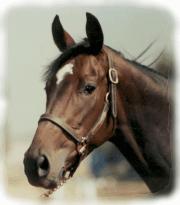A Horse, of Course with Don Blazer |
If you enjoy learning about horses, then you'll love our online courses. Each month you'll find a new column on our web site. We hope you'll enjoy it, and maybe e-mail us with questions or suggestions for other columns. A Horse, Of Course is a monthly column syndicated by Success Is Easy. If you like the column, call your local newspaper, or local horse publication and ask them to subscribe by contacting Success Is Easy. |
Water For My Horse Don Blazer copyright©2012 |

When pure, it is odorless,
tasteless, and transparent. Without it, life on earth is impossible. It is one of the best solvents. It makes up the greater portion of the horse’s body, and he likes to keep it that way. Its chemical formula is H2O. It’s water, and most horses don’t get enough; at least not enough of the right kind. Without food a horse could live about 50 days. Without water a horse might live 12 days. Even the novice horseman gives consideration to the type and amount of food her horse gets, and there are plenty of vitamin and mineral supplements on the market to keep the average horse owner busy for years guessing what might be needed. (Most likely none.) But who stops to make a careful appraisal of her horse’s water supply? There are more horses in poor condition due to a lack of sufficient water than through a lack of sufficient food. There are three things to consider in providing the horse with water: 1. how much he gets 2. when he gets it 3. what kind he gets. A 15 to 16-hand horse that is stabled, not doing hard work, and eating dry food, needs about 12 gallons of water each day during fairly cool weather. If the weather is not and the horse is working hard, you can double that amount. A constant supply of fresh, clean water is best. The horse can then drink in the amount he wants whenever he is thirsty. The horse’s stomach has a lot to do with making this the preferred arrangement. The horse has a small stomach for his size, and the exit of the stomach is directly opposite the entrance and is larger than the entrance. So if you give water to a thirsty horse that has already started to eat, the fluid will wash undigested particles of food out of the stomach and into the intestines. The frequently leads to colic, not to mention that the digestive juices necessary for absorption of food will be diluted to such a degree that they may be rendered nearly ineffective. The horse that doesn’t have free access to water should be given water before he is fed, never right after feeding. It is also a poor idea to water a horse just before working him. The horse’s stomach does not lie on the belly wall, but it suspended within the body of the horse. It lies against the diaphragm, which separates it from the lungs. If the stomach is full of water or good, the capacity of the lunges to take in oxygen is reduced, and the horse will be under greater strain, which can lead to broken wind. Contrary to popular belief, a horse may be given a drink while he is being worked, even if he is sweating. A horse that is hot from work can be allowed to drink, even cool water, providing the handler keeps the horse moving until he has cooled down. The mistake is not in letting the horse drink, but in giving him a drink and then not “cooling him out” properly. Automatic water devices have advantages: they provide the horse with all the water he wants when he wants it, and they generally assure the water is fresh and clean. However, they can become plugged, dirty or accidentally turned off, so they must be checked at least twice a day. Never position an automatic water bowl so that it gets direct sun during the summer months; usually the bowl is small and the water can heat up to the point a horse will not drink. If the water bowl is metal, it can become so hot as to burn the horse’s muzzle. Thirty-gallon plastic trash barrels make good water containers for horses. If checked twice a day, they provide a constant supply of water, and if they are cleaned regularly the water stays fairly fresh. In addition, horses have a difficult time breaking them or getting injured on them. Using the old-fashioned common watering trough is a bad practice since it usually not cleaned often enough and consequently provides an excellent means of spreading disease from one horse to another. Never let your horse drink from a common trough when you are riding at a public park or trail…make arrangements to provide fresh water for your horse before you head out at a public facility. Every time you’re thirsty, think about your horse. He doesn’t need a cola, an un-cola, or a V-8. All he needs is a drink of fresh, clean water. |